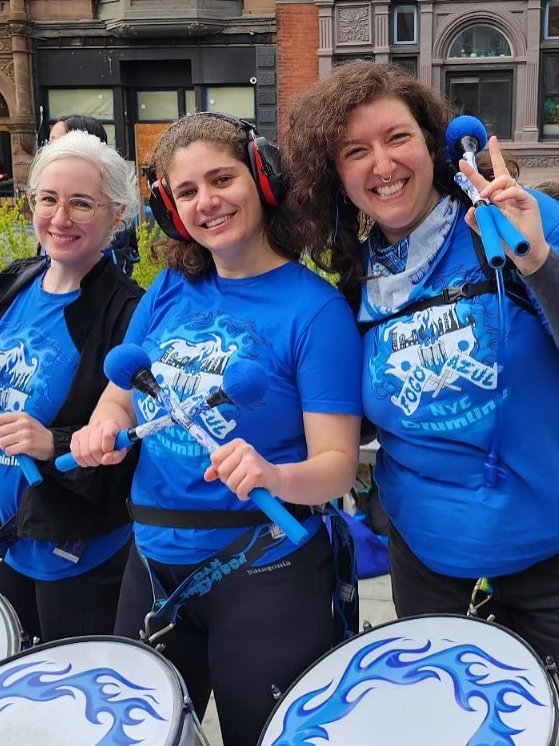What’s That Drum? Surdo 1 and Surdo 2
Surdo
It’s impossible to miss the mighty surdo section of Fogo Azul—not only because of the massive amount of sound the section creates, but also because of the hefty size of the surdo drums and the tremendous number of surdo players. Of all the drums in the band, the surdo is the largest in size, which means that it produces the lowest sound you’ll hear. More often than not, these drums are marking the large beats within the band, establishing the speed of the music and providing a structure that is foundational to the other parts. Ironically, Surdo translates to “deaf” in Portuguese.
Within the surdo section, the drums are split into two groups that are defined by their pitch (how high or low the drum sounds). Surdo 1 drums have the deepest or lowest pitch, and surdo 2 drums sound just a bit higher. Also, the two groups are defined by which beats they play. Surdo 1 players hit on beats 1 and 3, whereas surdo 2 players hit on beats 2 and 4. In this way the groups are complementary, with the first group establishing a base and the second group driving the music forward. Together as a powerful, interlocked team, they create a rhythmic framework that the band calls “heartbeat.”
The surdo players also physically define the structure of the band. In the words of surdo 1 section leader Kat Almirañez, “the surdo section is unique in terms of where we are placed in the band’s line-up. We all spread out along the perimeter, as though we are carrying and protecting the music.” Powering the band down the parade route with their heartbeat rhythm, the surdos can certainly catch the attention of a crowd. If you ask a surdo player why they joined the band, you’ll probably hear how the powerful surdo booms won them over from first listen.
“When you play the surdo, you don’t just hear it. You feel it in your whole body, and it sticks with you.”
Surdo 2 section leader Helena Pires was one of those audience members drawn to the surdo. “I just love the sound” Helena said, “when you play the surdo, you don’t just hear it. You feel it in your whole body, and it sticks with you.” With five years under her drumming belt, Helena now welcomes new members into the band regularly as part of the new member volunteer team. When I asked her how someone might choose between surdo 1 and surdo 2, she said, “Everybody is either a natural one or two, and you can’t control that. The body will take over and do its thing naturally. I love watching that when new people try [the surdo].”
Kat similarly described surdo playing as an immersive and full body experience: “The sound of the surdo travels through you and makes you feel powerful!” As a surdo 1 section leader, Kat also plays a role in teaching new members in the band, so I asked her what traits make a great surdo player. “I think kindness, attentiveness, and enthusiasm are really important” Kat described, “And it does take stamina to play surdo too!”
Long-time surdo players can attest that they have built up surdo-stamina, learning to produce the most resonant sound possible on their instruments. “When people begin, they are sometimes timid because the surdo does have such a big boom.” Helena said, “It can be challenging for players to realize that the drum is not going to break, so you can hit really hard.”
Don’t miss our next
“Whats That Drum?”
feature, coming soon.
Thanks! - Hattie from the Dobra section












